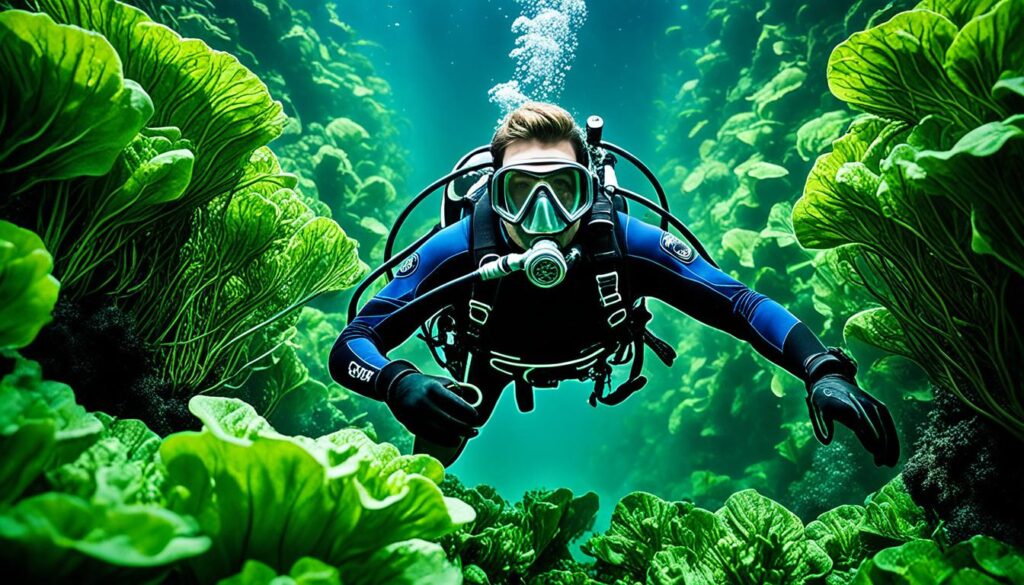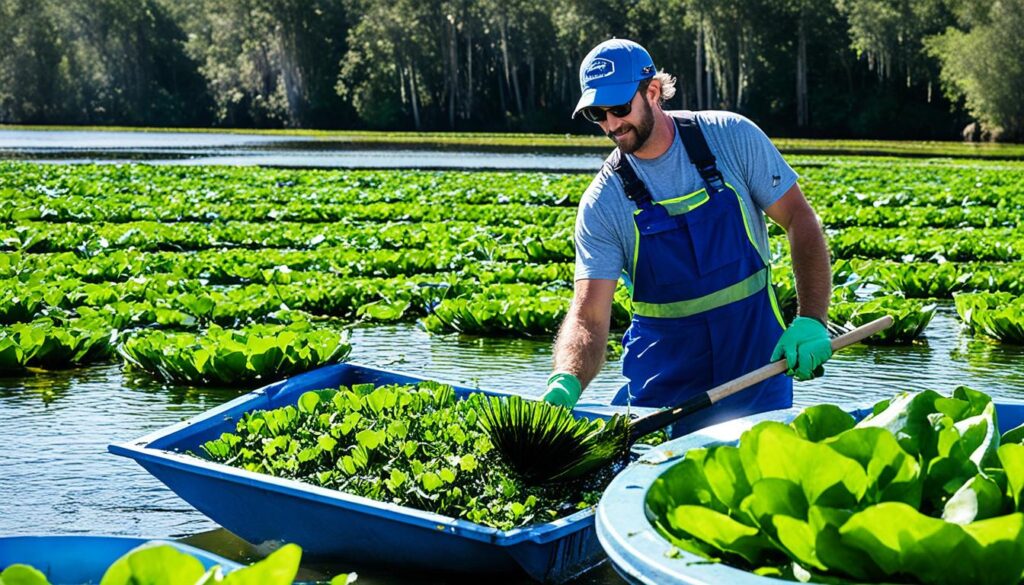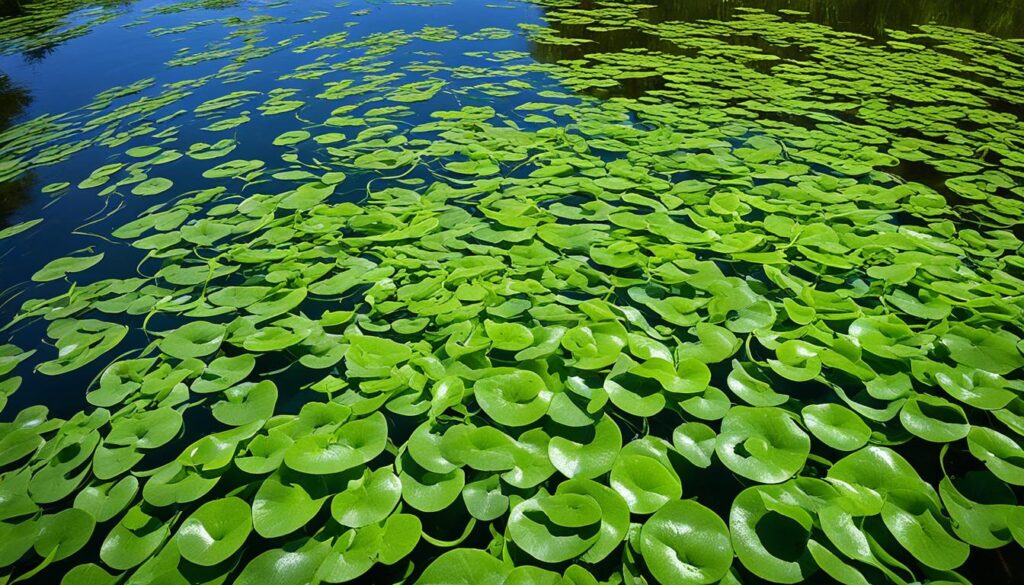Welcome to an informative journey exploring the ecological impact of Water Lettuce, an invasive aquatic plant species wreaking havoc in Florida’s water bodies. In this article, I will shed light on the characteristics of Water Lettuce, its adverse effects on native ecosystems, and effective management strategies to mitigate its spread.
Water Lettuce, scientifically known as (Pistia stratiotes), is a free-floating plant species that has forcefully established itself in various water bodies across the Sunshine State. Native to tropical regions, this dense, mat-like plant has thrived in Florida’s warm climate and abundant water resources, making it a formidable invasive species.
Angler’s Essentials:
- Water Lettuce is one of Florida’s invasive aquatic plants that is causing significant ecological disruptions.
- It outcompetes native flora, leading to imbalances in aquatic ecosystems.
- Water Lettuce reproduces rapidly, further exacerbating its invasiveness.
- Effective control and management strategies are essential to mitigate the spread of Water Lettuce.
- Prevention and long-term management practices are crucial for protecting Florida’s native aquatic species from this invasive plant.
Understanding Water Lettuce in Florida
Water Lettuce is an invasive aquatic plant that has become a significant concern in Florida’s water bodies. Its ability to rapidly colonize and outcompete native flora poses a threat to the delicate balance of aquatic ecosystems.
Originally from South America, Water Lettuce was introduced to Florida as an ornamental plant. However, its aggressive growth and reproductive methods quickly led to its classification as an invasive species. This hardy plant thrives in warm climates, making Florida’s aquatic environments an ideal habitat for its proliferation.
One of the key characteristics of Water Lettuce is its ability to reproduce asexually, enabling it to rapidly spread. As it multiplies, it forms dense mats of floating vegetation on the water’s surface, which can cover large areas and block sunlight from reaching submerged plants. This hampering of sunlight availability significantly affects the growth and survival of native aquatic vegetation.
Moreover, Water Lettuce’s vigorous growth rate allows it to quickly outcompete indigenous plants for essential resources such as nutrients and space. The plant’s large, inflated leaves create a dense canopy, shading out submerged plants and restricting their access to sunlight. This in turn disrupts the natural balance of the ecosystem, affecting the biodiversity and overall health of Florida’s water bodies.
Water Lettuce’s ability to rapidly colonize and outcompete native plants is a cause for concern. Its aggressive growth can lead to the displacement and decline of native aquatic species, further exacerbating the ecological impacts.
Efforts to control Water Lettuce in Florida require a comprehensive understanding of this invasive aquatic plant and its behavior patterns. By recognizing its growth mechanisms and competitive advantages, appropriate management strategies can be implemented to mitigate its negative effects and protect the native biodiversity of Florida’s water ecosystems.
Characteristics of Water Lettuce
| Key Characteristics | Impact |
|---|---|
| Rapid growth rate | Forms dense mats that block sunlight and affect other aquatic plants |
| Asexual reproduction | Allows for rapid spread and colonization of water bodies |
| Ability to outcompete native plants | Displaces and disrupts indigenous aquatic species, leading to imbalances in ecosystem dynamics |
The invasion of Water Lettuce in Florida’s water bodies necessitates proactive management approaches to prevent further spread and damage. In the following sections, we will explore the ecological consequences of Water Lettuce and discuss effective strategies for its control and long-term management.
The Ecological Consequences of Water Lettuce
Water Lettuce, an invasive aquatic species in Florida, poses significant ecological consequences for the state’s water bodies. Its uncontrolled growth and spread have led to severe disruptions in native ecosystems and have become a major concern for water quality management.
Disruption to Native Species
The invasive nature of Water Lettuce allows it to outcompete and displace native plants. Its rapid growth and ability to form dense mats on the water’s surface restrict sunlight penetration, depriving submerged plants and algae of essential light for photosynthesis. As a result, native vegetation struggles to survive, disrupting the balance of the ecosystem.
Water Quality Degradation
Controlling invasive plants in water bodies, such as Water Lettuce, is crucial to preventing water quality degradation. The dense mats created by Water Lettuce impede water flow, reducing oxygen exchange and promoting stagnation. This can lead to increased nutrient concentrations, algal blooms, and decreased dissolved oxygen levels, negatively impacting aquatic organisms.
Imbalance in the Ecological Balance
The unchecked spread of Water Lettuce upsets the delicate ecological balance in Florida’s water bodies. It disrupts the food chain by altering the habitat and availability of resources for various organisms. Additionally, the extensive coverage of Water Lettuce inhibits the movement of fish, turtles, birds, and other species, further impacting the overall biodiversity of the ecosystem.
“The ecological consequences of Water Lettuce highlight the urgency of implementing effective strategies for controlling and managing this invasive species in Florida’s water bodies.”
To mitigate the ecological consequences, it is essential to implement proactive measures for controlling invasive aquatic species in Florida. This includes diligent monitoring, timely removal, and comprehensive management strategies that target Water Lettuce specifically. By doing so, we can protect the native flora and fauna, restore ecological balance, and ensure the sustainability of Florida’s water ecosystems for future generations.
Strategies for Managing Water Lettuce
Controlling Water Lettuce in Florida requires implementing effective management approaches that target its growth and spread. Both manual and chemical control methods have been utilized, each with their own advantages and limitations.
Manual Control Methods
Manual removal techniques for managing Water Lettuce involve physically removing the plants from the water bodies. This can be accomplished through the use of nets, rakes, or by hand-pulling. When performing manual removal, it is important to ensure that all plant fragments are properly disposed of to prevent reinfestation.
“Manual control methods are resource-intensive but can be highly effective, especially when managing smaller areas or where chemical control is not suitable.”
Chemical Control Methods
Chemical control methods involve the use of herbicides to target and manage Water Lettuce in Florida. These herbicides are specifically designed to kill or inhibit the growth of aquatic plants. It is important to follow the instructions provided by the product manufacturer and adhere to any state or local regulations regarding herbicide use.
When using herbicides, it is crucial to consider the potential impacts on non-target species and the overall aquatic ecosystem. Engaging professional applicators who are trained in herbicide use can help ensure effective and responsible chemical control of Water Lettuce.
Integrated Approach
In many cases, a combination of manual and chemical control methods is necessary to effectively manage Water Lettuce infestations in Florida. This integrated approach allows for targeted removal and suppression of the plant while minimizing ecological impacts.
Pros and Cons of Water Lettuce Control Methods
| Control Method | Pros | Cons |
|---|---|---|
| Manual Removal | – Directly removes plants | – Labor-intensive – May be time-consuming |
| Chemical Control | – Can target large infestations | – Potential ecological impact – Requires expertise |
| Integrated Approach | – Combines effectiveness of both methods | – Requires careful planning and coordination |
Implementing water lettuce control methods in Florida requires thorough planning, proper training, and adherence to regulatory guidelines. It is essential to consider the unique characteristics of the infested area and select the most appropriate control strategy to effectively manage Water Lettuce and protect the native aquatic ecosystems.
Controlling Water Lettuce in Aquatic Environments
Controlling water lettuce in aquatic environments can be challenging due to its rapid growth and ability to outcompete native plants. Fortunately, there are specific techniques and tools available to effectively manage this invasive species in various aquatic settings such as lakes, ponds, and rivers.
One method of controlling water lettuce is through manual removal. This involves physically pulling out the plants from the water, ensuring to remove the entire plant, including the roots. It is important to dispose of the plants properly to prevent their spread to other water bodies.
Another effective approach is the use of herbicides. Selective herbicides can be applied directly to the foliage of water lettuce, targeting the plant without harming surrounding vegetation. However, it is crucial to follow the instructions and regulations provided by local authorities and use herbicides responsibly to minimize any negative impacts on the aquatic ecosystem.
| Controlling Water Lettuce in Aquatic Environments | Pros | Cons |
|---|---|---|
| Manual Removal | – Environmentally friendly – Does not require chemical application | – Labor-intensive – May not be suitable for large infestations |
| Herbicide Application | – Effective in targeting water lettuce – Can cover large areas | – Potential harm to non-target species – Requires careful application |
Implementing a combination of manual removal and herbicide application can yield the best results in controlling water lettuce. Regular monitoring and follow-up treatments are necessary to prevent re-infestation and ensure long-term management.
It is worth noting that prevention plays a crucial role in managing water lettuce. Taking steps to avoid introducing this invasive plant to new water bodies, such as cleaning boats and equipment before moving them between locations, can help reduce its spread. Additionally, raising awareness about the importance of responsible aquatic plant management among the community is essential for long-term control.
To summarize, controlling water lettuce in aquatic environments requires a proactive and multi-faceted approach. By employing manual removal, herbicide application, and promoting prevention measures, we can effectively manage and mitigate the impact of water lettuce in Florida’s delicate aquatic ecosystems.

Florida Water Lettuce Removal Techniques
When it comes to the removal of Water Lettuce in Florida, timely action is crucial. In this section, we will explore specialized techniques and equipment that can effectively tackle the invasive aquatic plant. It’s important to note that a combination of mechanical and biological approaches yields the best results.
Mechanical Removal
One effective method for removing Water Lettuce is through mechanical means. This involves physically removing the plant from the water body using various tools. Some popular methods include:
- Hand Pulling: Small-scale infestations can be manually addressed by carefully pulling out the plants by hand. It’s important to remove the entire plant, including the root system, to prevent regrowth.
- Netting: Using nets or screens, Water Lettuce can be skimmed off the water surface. This method is particularly useful for larger infestations or open water bodies.
- Harvesting Machines: In the case of extensive Water Lettuce spread, harvesting machines can be employed. These machines are equipped with cutting blades that sever the plants from their roots, allowing easy removal.
Biological Control
In addition to mechanical methods, biological control can be an effective long-term solution for managing Water Lettuce. This approach involves introducing natural enemies or organisms that feed on the invasive plant, helping to control its growth. Some biological control techniques include:
- Biological Agents: Biological agents such as insects, fish, or microorganisms can be introduced to water bodies to feed on Water Lettuce. These agents target the plant, reducing its population and preventing further growth.
- Algae Competition: Introducing specific algae species that outcompete Water Lettuce can help control its growth. The algae consume the nutrients and resources that the invasive plant relies on, ultimately weakening its presence.
- Herbivorous Fish: Certain species of herbivorous fish, such as Grass Carp, can be used to control Water Lettuce infestations. These fish feed on the plant, effectively reducing its spread in the water body.

Implementing a combination of mechanical and biological control methods, tailored to the specific situation, is key to successfully removing Water Lettuce in Florida. It’s crucial to monitor the progress and adapt the strategies accordingly to ensure long-term management and prevent reinfestation.
Prevention and Long-Term Management
When it comes to managing water lettuce in Florida and combating the spread of invasive aquatic plants, prevention and long-term management are key. By implementing proactive measures and educating the public, we can effectively control the growth and impact of water lettuce on our precious aquatic ecosystems.
One crucial aspect of prevention is the establishment and enforcement of policies that regulate the introduction and transportation of aquatic plants. By implementing strict regulations, we can minimize the unintentional introduction of water lettuce and other invasive species into our water bodies.
Education is another vital component of prevention and long-term management. Informing the public about the detrimental effects of water lettuce and the importance of responsible aquatic plant management practices can empower individuals and organizations to take action against its spread. Public awareness campaigns, workshops, and educational materials can go a long way in ensuring that everyone understands their role in protecting Florida’s water resources.
“Prevention is always better than cure. By focusing on preventive measures, we can stop the introduction and spread of water lettuce before it becomes a widespread problem.”
Responsible aquatic plant management practices are essential for long-term management. Regular monitoring and early detection of water lettuce populations can enable timely intervention and prevent its rapid expansion. In addition, proper maintenance of water bodies, such as regular removal of dead plant material and debris, can create unfavorable conditions for water lettuce growth.
By adopting integrated management approaches that combine physical, mechanical, and chemical control methods, we can effectively manage water lettuce in Florida. Physical methods, such as manual removal and barriers, can be used in smaller areas to physically block or remove water lettuce. Mechanical methods, like the use of specialized equipment, can effectively remove larger infestations.
Chemical control methods involving the use of herbicides can be effective in larger water bodies, but they must be used judiciously and in accordance with regulatory guidelines to minimize their impact on non-target organisms and water quality.
“Combining different management strategies and tailoring them to specific environments can enhance the overall effectiveness of water lettuce control efforts.”
In conclusion, preventing the introduction of water lettuce and implementing long-term management strategies are crucial steps in managing water lettuce in Florida. Through policies, education, and responsible practices, we can protect our aquatic ecosystems and preserve the natural biodiversity that makes Florida’s waters so unique.
Conclusion
Throughout this article, we have explored the impact of Water Lettuce as an invasive aquatic plant in Florida. Its rapid growth and ability to outcompete native species pose a significant threat to the delicate balance of our aquatic ecosystems. It is crucial that we take proactive measures to mitigate the spread of Water Lettuce and protect Florida’s biodiversity.
Effective management strategies are key to controlling the invasive spread of Water Lettuce. By implementing a combination of manual and chemical control methods, we can limit its expansion and minimize its negative ecological consequences. Additionally, specialized techniques and equipment can be utilized for the successful removal of Water Lettuce, ensuring the health and sustainability of our water bodies.
Prevention and long-term management are essential aspects of addressing the Water Lettuce invasion. By raising awareness, implementing policies, and promoting responsible aquatic plant management practices, we can reduce the introduction and spread of this invasive species. With collective efforts, we can protect Florida’s aquatic ecosystems from the detrimental effects of Water Lettuce and preserve the ecological balance for future generations.
FAQ
What is Water Lettuce?
Water Lettuce is an invasive aquatic plant species that is prevalent in Florida. It is characterized by its floating rosette-like structure and lettuce-like appearance, with clusters of light green leaves.
Why is Water Lettuce considered an invasive species in Florida?
Water Lettuce is considered invasive in Florida because it has the ability to quickly reproduce and outcompete native plants for resources. Its dense mats can cover large areas of water bodies, restricting sunlight penetration and interfering with natural water flow.
What are the ecological consequences of Water Lettuce in Florida?
The presence of Water Lettuce can have several negative ecological impacts. It degrades water quality by releasing excessive nutrients and organic matter, leading to decreased oxygen levels. It also disrupts native habitats and can cause imbalances in the food web by reducing the availability of resources for other aquatic organisms.
How can Water Lettuce be controlled in Florida?
There are various control methods for managing Water Lettuce in Florida. Manual removal, such as hand pulling or net skimming, can be effective for small infestations. Chemical control methods, utilizing herbicides approved for aquatic use, can also be employed, but caution must be taken to ensure minimal impacts on non-target species.
How can Water Lettuce be controlled in aquatic environments?
Controlling Water Lettuce in aquatic environments involves implementing targeted techniques. This can include physical barriers, such as bottom barriers or shading, to prevent its spread. Biological control methods, such as the introduction of specific herbivorous insects or fish, can also be used to reduce its population and limit its growth.
How can Water Lettuce be removed in Florida?
Removing Water Lettuce in Florida may require specialized techniques and equipment. Mechanical removal methods, such as the use of aquatic harvesting machines, can be effective for large-scale infestations. Additionally, environmental dredging or the application of innovative technologies, like ultrasound or laser treatment, may be considered in more challenging situations.
How can Water Lettuce be prevented and managed in the long term?
Prevention and long-term management are key in controlling Water Lettuce. This involves implementing proactive measures, such as regular monitoring and early detection systems, to identify and address new infestations promptly. Additionally, educating the public about the risks of introducing invasive aquatic plants and promoting responsible aquatic plant management practices can help prevent the spread of Water Lettuce.
